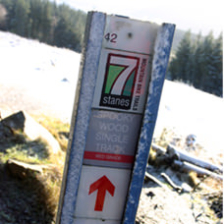Ticks in Scotland
Can dogs be protected against Ticks?
Yes they can. Your vet can advise on this and there are many products available over the counter. You can get sprays, spot-ons and special collars that are impregnated with chemicals that the skin of the dog absorbs. A tablet called Bravecto provides a 3 monthly protection against the affects of ticks. Most of these ensure the tick dies very quickly after biting the dog. In most cases it will just fall off.
What time of year do they bite?
Typically ticks are more prevalent in spring and autumn however they are know to exist through summer as well. They are to be found most like in woodland and grassland areas.
How to find ticks on your dog?
After your walk we suggest you give your dog a good all round body check. When we do this we tend to start at the nose and work our way back. The muzzle and ears can be good hiding areas, so focus there. Then take a brush and methodically check the body of your dog. This will take no more than a couple of minutes. It is worth a second check 12 hours or so later in case you missed one and it is now attached to the skin. If it has, see below on removal techniques.
How to remove a tick?
If a tick has attached itself to your dog so not squeeze it or grab it to remove. All you will achieve is squeezing the poisonous blood back into your dog. Tweezers can have the same effect. The best way to remove the tick is with a tick removal tool. These cheap and ingenious gadgets allow you to get between the tick and the skin and gently remove the tick with a gentle rotation. It is really simple and effective. We recommend this tick remover. If you search tick removal tool you will find them quickly on Amazon.
This can all sound quite scary to someone who has not had their dogs in areas where ticks exist. Let us reassure you that this problem is minor as soon as you are aware of it; which you are now. As long as you have taken precautions, do a post walk check and have a tick remover in your holiday packing then, at most, this will only be a minor inconvenience.
It is a good idea to understand how to prevent ticks attaching to you and your dog, as well knowing the very simple but specific way to remove them if found. Please see our dedicated Tick resource page for some worthwhile and important advice.
Ticks are small parasites similar to spiders that suck the blood from other animal. Like a spider they have an egg shaped body and have eight legs. They grow in size if they have attached to an animal and are filled with blood. Ticks are prevalent in Scotland and see dogs just like any other furry animal – a blood meal.
Ticks are more likely to attach to animals, however they can also attach to humans. They can carry lymes disease so it is important for humans to regularly check that one has not not attached itself to you. If it has please read the removal technique shown below to safely detach from the skin.



















